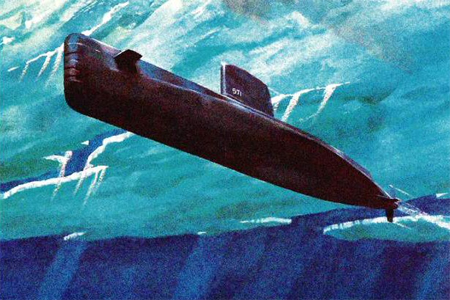The USS Nautilus under the Polar ice cap.
On August 3, 1958 the USS Nautilus, the U.S. Navy’s first nuclear powered submarine, crossed the North Pole under the Polar icecap. Under the command of Captain William R. Anderson, 111 officers and crew plus four civilian scientists were on board when the ship submerged off of Point Barrow, Alaska and sailed without surfacing over 1,000 miles before passing under the Pole. She then continued submerged until she finally surfaced between Greenland and Spitzbergen on August 5.
Within days the achievement was touted to the press as a scientific breakthrough as part of the widely hyped International Geophysical Year. President Dwight D. Eisenhower awarded Anderson the Legion of Merit.
1968 action thriller Ice Station Zebra starring Rock Hudson and Ernest Borgnine, a U.S. nuclear submarine is sent on a mission to save the crew of a weather station on the ice near the North Pole but are confronted by Soviet paratroopers in a stand-off that could lead to nuclear war. The film was based on the dangerous game played by both nations at the top of the world
But there was more—much more—than science afoot in the Arctic. The real reason for the mission was the strategic game of cat and mouse being played between the U.S. and the Soviet Union over control of Arctic waters. Submarines of both nations prowled the water there for decades during the Cold War often resulting in dangerous, but highly classified, confrontations. The films Bedford Incident and Ice Station Zebra were based on this perilous game.
The USS Nautilus was built in Groton, Connecticut by General Dynamics Electric Boat Division under the personal supervision of Admiral Hyman G. Rickover, the Father of the Nuclear Navy. Her power plant was the S2W naval reactor, a pressurized water reactor by Westinghouse Electric Corporation and is the basis for the design of nuclear propulsion still used by navies around the world.
Mamie Eisenhower did the honors at the launch of the Nautilus in 1954.
She was christened by Mamie Eisenhower on January 21, 1954, ran under nuclear power on the morning of January 17, 1955, and was commissioned on September 30, 1954, under the command of Commander Eugene P. Wilkinson. She almost immediately began to smash records for endurance—total time submerged, and distance traveled. In the mid-‘50s she was the most publicized ship in the Navy, her very existence a cautionary shot over the bow of Soviet naval ambitions.
The ship remained in service until decommissioned in 1980. Since 1986 the USS Nautilus has been on display at the Submarine Force Museum in Groton.
She was named for the famous submarine build and sailed by mad Captain Nemo in Jules Verne’s pioneering science fiction novel Twenty Thousand Years Under the Sea first published in France in 1870. As you may recall Nemo wanted to build a super weapon that would enforce world peace by making war too terrible to contemplate—just the supposed mission of American nuclear arms.
Jules Verne's mad captain on the deck of his submarine The Nautilus in and illustration from an early English edition of Twenty Thousand Leagues Under the Sea.
Today the vast polar ice cap under which the Nautilus sailed has greatly shrunk under conditions of relentless climate change. For summer months there is now open water completely around the sea ice, which is also thinning and apt to break up. Polar bears, walrus, and fur seals are all endangered as are the livelihoods of indigenous peoples in the Arctic from Siberia, Alaska, Canada, and Greenland.
A 2021 satellite image shows greatly reduced sea ice around the North Pole.
Nuclear submarines from the U.S., Russia, and the United Kingdom have all surfaced through less than three feet of ice near the Pole.



.jpg)

No comments:
Post a Comment